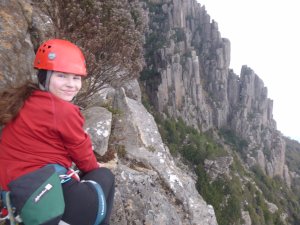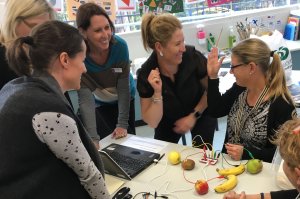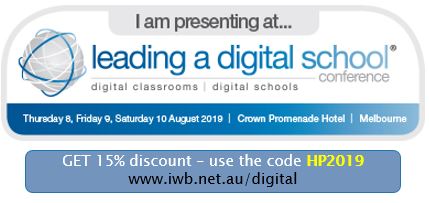
“Come to the edge.
We might fall.
Come to the edge.
It’s too high!
COME TO THE EDGE!
And they came,
and he pushed,
and they flew.”
Christopher Logue – New Numbers
A new era
More than ever before we are asking teachers to step out of their comfort zones. 20 years ago, most PL meant tweaking existing practices in known content areas. A chalk and talk session where teachers could sit and listen, and take notes on new ideas was a perfectly appropriate and effective forum. Soon, the buzz of collaborative teams began to infiltrate PL, and the power of teacher voice meant we could learn from each other, not just the sage on the stage. In reality though, pedagogies and content areas in PL still sat neatly within the paradigms of teachers’ own educational experiences as a student.
With the ubiquitous nature of digital technologies in our students’ lives, we are, in a comparatively short time frame, asking teachers to make monumental shifts into areas that appear quite foreign.
- Let the students lead the learning What?!
- Integrate digital technologies Sorry, I’m just not good with all this techy stuff…
- Move from the safety of the classroom into authentic real world learning But I won’t be able to cover the curriculum!
Like an abseil, these big conceptual leaps about how teachers perceive their role in a school often evoke fear and anxiety, resulting in either active resistance or passive avoidance.
PL that acknowledges fear and uncertainty as legitimate starting points, that embraces risk, and guides and celebrates learning through vulnerability.
It is clear that leaders who are committed to advancing cultures of innovation need to be intentional in providing PL that addresses not only content and pedagogies, but also supports teachers’ emotional growth. PL that acknowledges fear and uncertainty as legitimate starting points, that embraces risk, and guides and celebrates learning through vulnerability.
A fresh lens
In the past 18 months, I have sat through too many PL sessions (sat being the operative word) about emotional connection to learning, student centred learning, active and inquiry based approaches and found that 50 minutes in we are all still sitting in our chairs, digesting a PowerPoint of words, without having had an opportunity to share, experience, reflect or challenge our assumptions with our peers.
Let’s add a fresh lens to PL. A lens that is unashamedly intentional about modelling the very ways in which we are wanting students to learn.
A time for doing
“Tell me and I forget, teach me and I may remember, involve me and I learn” Benjamin Franklin
We know learners need to do. We know learners need multiple avenues to explore new ideas and connect to existing knowledge. It may be do first, reflect later. It may be think first, do later. It may be thinking and doing concurrently. Irrespective of the order, for something to become deeply understood, a learner must have the opportunity to engage in the body-mind connection, and develop meta-cognitive awareness about their own learning experiences. Mindset alone is not enough. Teachers need to know their competencies in teaching in a new and exciting way.
Last year I took my 14 year old daughter climbing on the Organ Pipes – large dolorite cliffs over 120 metres tall, on the eastern face of Mt Wellington.

After climbing two 30 metre pitches, she looked down and was hit by the reality of the 50 metre rockface we had to abseil. I’d told her about it, so it was in her mindset before we started the day “yes, I’m going to abseil down that cliff”. Sitting on top of the cliff, knowing it was the only way down she frantically sought both active and passive avoidance “I’ll pay for a helicopter” or “I’ll just sleep up here”.
Talking about abseiling and actually leaning backwards over the edge are two completely different things. In theory you can know that it will be safe but scary. Experiencing abseiling is completely different. Heart racing, palms sweating, legs shaking, the internal dialogue of the mind “I’m gonna die!”. The complex emotions involved in knowing these feelings of uncomfortableness, of fear, and feeling out of control, YET pursuing it anyway, and the subsequent elation and pride are things that can only be felt and experienced, not taught.
Teaching in scary territory
We are asking teachers to take a leap into scary territory.
If a teacher hasn’t recently experienced learning in an experiential, inquiry based way, how can they possibly trust that the chaos that they see in front of their eyes will in fact lead to deeper learning? The confusion, frustrations of problem solving with technology, heated discussions, multiple dead ends that they see their students go through as they try to navigate complex learning may well turn a teacher off rethinking the ways in which they teach. But having experienced and reflected on learning like this themselves in PL, teachers will recognise that their students are not only learning about content, but about learning itself, and specifically, about their personal capabilities as a learner.
teachers and students are learning about their personal capabilities as a learner
Are we, as leaders, empowering, trusting and supporting teachers to work through challenging emotions in order to grow themselves firstly as learners, and then as teachers? PL needs to be carefully planned so that the risk is calculated, and perceived risk only. In the same way I wouldn’t send my daughter off a 50m cliff with a 30 metre rope or a frayed harness, leaders need to make sure teachers are provided with the right tools and guidance to ensure their own, and consequently their students’, success.
Our Leadership Challenge
The challenge in encouraging teachers to integrate Digital Technologies into teaching is not addressing the question “is this possible?” coz we see it around us all the time, on every innovate teacher’s YouTube channel, Tweet or Facebook feed – of course it’s possible! At the heart of Digital Technologies PL in regular schools with regular educators is getting teachers to answer “can I do this?” And the answer is undoubtedly yes – if equipped with the right resources, mindset and competencies, and the FEELING of having moved through the unknown and the challenge themselves.

As leaders, if we allow teachers to take the helicopter and never experience and reflect on the feelings associated with learning in a risky way, it is unfair to expect huge shifts in practice. We can’t impose our redefinition of the role of educators without firstly guiding teachers to understand their own competencies in teaching in a new and exciting way.
Plan to Pump PL:
- Be clear about intended emotional outcomes of the PL. Is it to generate enthusiasm, build teams, push into new areas, challenge assumptions, consolidate understanding?
- Guide learners to make body-mind connection (meta-cognition)
- Include reflection time to connect teachers’ own learning experiences to student learning
- Be transparent about the intentional structuring of the PL
- Plan appropriate scaffolds to ensure success
I am presenting at the Leading a Digital School Conference in August in Melbourne and would love to see you there. One of my sessions is under the Mega Theme of Advancing Cultures of Innovation and the Sub Theme of Rethinking the Role of Teachers.
Session: Pump your PL
Why mindset alone is not enough for teacher transformation – a practical workshop on how to use digital tools to pump teacher PL. More than just novelty, each of these strategies models intentional pedagogies that has teachers firstly ‘doing’, then reflecting on their own engagement as a learner in order to transfer progressive learning experiences for their students. Flipped learning using AR, peardeck, 365, secret pedagogy missions, solving complex problems, flipgrid, mission impossible, YouTube, Padlet, virtual wellbeing gallery. Feedback from teachers – this is PL that sticks and initiates action…in fact it was named up in school data as positively contributing to teacher wellbeing!
